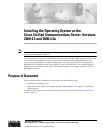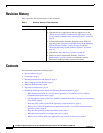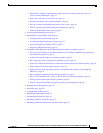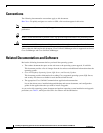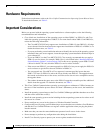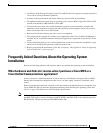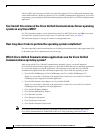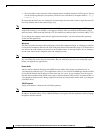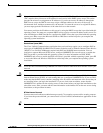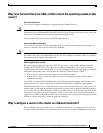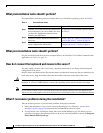
6
Installing the Operating System on the Cisco Unified Communications Server, Versions 2000.4.3 and 2000.4.3a
OL-10221-02
Hardware Requirements
Hardware Requirements
For hardware requirements, refer to the Cisco Unified Communications Operating System Release Notes.
To obtain the document, see Table 2.
Important Considerations
Before you proceed with the operating system installation or software update, review the following
recommendations and information:
• Cisco labels new installations of the operating system as either 2000.4.3 or 2000.4.3a, and Cisco
labels the operating system upgrade as 2000.4.3a. For some details about 2000.4.3 and 2000.4.3a,
review the following information:
–
The Cisco MCS-7825-H2 only supports new installations of 2000.4.3a (not 2000.4.3). All other
servers that are listed in the release notes support new installations of 2000.4.3 or 2000.4.3a. To
obtain the release notes, see Table 2.
–
If you are performing a new installation and want to identify the version of the operating system
installation that your server supports, locate the operating system installation disk that ships in
your software kit.
–
If you run 2000.4.3 on the Cisco MCS-7815-I2, Cisco strongly recommends that you apply a
2000.4.3a service release, for example, 2000.4.3asr1, as described in the “Installing Operating
System Software Updates” section on page 26. For this server, operating system 2000.4.3 lacks
a driver for the PCI-X card, which the 2000.4.3a service release includes.
–
If the server runs 2000.4.3, you cannot upgrade it to 2000.4.3a, but you can apply the 2000.4.3a
service releases to get the fixes that are available in 2000.4.3a.
–
You can upgrade any Cisco MCS or Cisco-approved, customer-provided server that runs
2000.2.7 (or later) to 2000.4.3a, unless the server already runs 2000.4.3. The upgrade detects
the current version that runs on the server, and if the server does not run a compatible version,
the upgrade aborts.
–
The readme document that posts next to the 2000.4.3a upgrade executable provides additional
details about the upgrade. To obtain the document, see Table 2.
• This Cisco Unified Communications operating system requires a minimum of 2 GB of memory on
the server. If the installation process detects less than 2 GB memory on the server, the installation
aborts.
• Install the operating system image on the Cisco Unified CallManager publisher database server first
and then on the subscriber server(s).
• Install the same operating system version including the latest operating system service release on all
the servers in a cluster.
• Do not configure any server in the cluster as a Windows Domain Controller.
• Configure the server by using static IP addressing to ensure that the server obtains a fixed IP address
and that the Cisco Unified IP Phones can register with the application when you plug the phones
into the network.
• Make sure that you enter the same administrator password on all servers in the cluster.
• Do not attempt to perform any configuration tasks during the installation.
• Install Cisco Security Agent to protect your servers against unauthorized intrusion.



